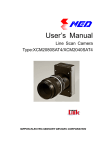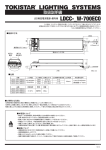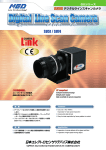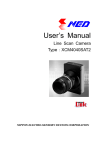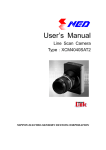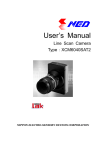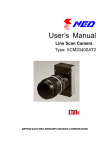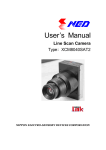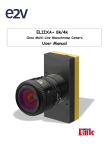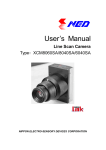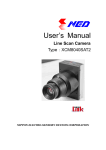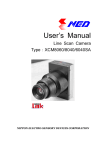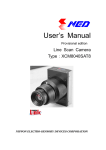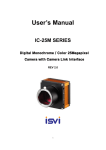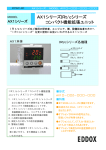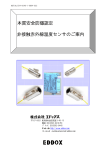Download Product Manual
Transcript
User’s Manual
Line Scan Camera
Type:XCM4040SAT4
NIPPON ELECTRO-SENSORY DEVICES CORPORATION
2
For Customers in the U.S.A.
This equipment has been tested and found to comply with the limits for a Class A
digital device, in accordance with Part 15 of the FCC Rules. These limits are
designed to provide reasonable protection against harmful interference when the
equipment is operated in a commercial environment. This equipment generates,
uses, and can radiate radio frequency energy and, if not installed and used in
accordance with the instruction manual, may cause harmful interference to radio
communications. Operation of this equipment in a residential area is likely to
cause harmful interference, in which case the user will be required to correct the
interference at his or her own expense.
For Customers in the EU
This equipment has been tested and found to comply with the essential
requirements of the EMC Directive 2004/108/EC, based on the following
specifications applied:
EU Harmonized Standards
EN55011:2007+A2:2007 Group1 Class A
EN61000-6-2:2005
*Group 1 contains all ISM (Industrial, Scientific and medical) equipment in
which there is intentionally generated and/or used conductively coupled
radio-frequency energy which is necessary for the internal functioning of the
Equipment itself.
*Class A equipment is equipment suitable for use in all establishments other
than domestic and those directly connected to a low voltage power supply
network which supplies buildings used for domestic purposes.
XCM4040SAT4
3
Introduction
Thank you for purchasing NED’s Line Scan Camera. We look forward to
your continued custom in the future.
For safety use
For your protection, please read these safety instructions completely before
operating the product and keep this manual for future reference.
The following symbols appear next to important information regarding safe
product handling.
Warning
If the product is not handled properly, this may result in
serious injury or possible death.
Caution
If the product is not handled properly, this may result in
physical injury or cause property damage.
Safety precaution
Warning
Never disassemble or modify this product, unless otherwise specified to do
so in this manual.
When hands are wet, avoid handling this product and do not touch any of the
connection cable pins or other metallic components.
Do not operate this product in an environment that is exposed to rain or other
severe external elements, hazardous gases or chemicals.
If the product is not to be used for an extended period of time, as a safety
precaution, always unplug the connection cable from the camera unit.
If the product installation or inspection must be executed in an overhead
location, please take the necessary measures to prevent the camera unit
and its components from accidentally falling to the ground.
If smoke, an abnormal odor or strange noise is emitted from the camera unit,
first turn OFF power, then unplug the cable from the camera unit.
This product is not intended for use in a system configuration built for critical
applications.
XCM4040SAT4
4
Instructions before use
Only operate this product within the recommended environmental
temperature range.
Use only the specified power source and voltage rating.
Do not drop this product. Avoid exposure to strong impact and vibrations.
Install the camera unit in a well-ventilated environment, in order to prevent
the camera from overheating.
If the camera must be installed in an environment containing dust or other
particles, take required measures to protect the camera unit from dust
adhesion.
Do not unplug the cable while power is being supplied to the camera unit. To
prevent product damage, always shut down the power supply before
unplugging the power cable.
When the surface of the camera window becomes dirty due to dust or grime,
black smudges appear in the displayed image. Use an air blower to remove
the dust particles. Dip a cotton swab into ethanol alcohol and clean the
camera window. Be careful not to scratch the glass.
Use of non-infrared lighting such as a fluorescent lamp is recommended. If
halogen lighting is employed, always install an infrared filter into your system
configuration.
For stabilized image capturing, turn ON the power supply and execute aging
for ten to twenty minutes before actually using the camera unit.
Do not share the power supply with motor units or other devices that
generate noise interference.
The signal ground (SG) and the frame ground (FG) are connected inside the
camera unit. Design the system configuration so that a loop will not be
formed by the ground potential differential.
Do not disconnect the camera while rewriting an embedded memory.
When you change exposure mode that is set at NED factory, input control
signal (CC1) from the capture board.
XCM4040SAT4
5
Exclusion Clause
The manufacturer assumes no responsibility for damages resulting from
natural disasters, earthquakes, or acts executed by a third party. Warranty
excludes any accidents resulting from improper handling or misuse of this
product, whether intentional or not, and any camera operations conducted
under abnormal conditions.
The manufacturer assumes no responsibility for any incidental damages
(loss of corporate profits, interruption of business, etc.) resulting form use or
non-use of this product.
The manufacturer assumes no responsibility for damages resulting from
failure to follow the instructions and procedures indicated in this User’s
Manual.
The manufacturer assumes no responsibility for any damages resulting from
malfunctions caused by combined use of this product with other peripheral
equipment.
The manufacturer assumes no responsibility for damages resulting from
malfunctions caused by non-authorized repair or modifications made to this
product.
XCM4040SAT4
6
Table of Contents
1 Product Outline ............................................................................. 9
1.1 Features ..................................................................................................................... 9
1.2 Application................................................................................................................. 9
1.3 Image Sensor........................................................................................................... 11
1.4 Performance Specifications ................................................................................... 12
2 Camera Setting and Optical Interface............................ 14
2.1 Setting the Camera ................................................................................................. 14
2.2 Fixing the Camera ................................................................................................... 14
2.3 Optical Interface ...................................................................................................... 16
3 Hardware ......................................................................................... 16
3.1 Camera Connection ................................................................................................ 16
3.2 Input / Output Connectors and Indicator .............................................................. 18
3.3 Connectors・Pin Assignments・Cables .................................................................. 19
3.4 Power Supply .......................................................................................................... 22
4 Camera Control ........................................................................... 23
4.1 Flow of Camera Control.......................................................................................... 23
4.1.1 Command Overview ......................................................................................... 23
4.1.2 Camera Receiving Message (PC Sending Command)................................... 23
4.1.3 Camera Sending Message (PC Receiving Message) ..................................... 24
4.1.4 Camera Control Commands ............................................................................ 25
4.1.5 Memory Setup Values (Factory Settings) ....................................................... 26
4.2 Details on Commands............................................................................................. 26
4.2.1 Setting Analog Gain ......................................................................................... 26
4.2.2 Setting Digital Gain........................................................................................... 27
4.2.3 Setting Digital Offset ........................................................................................ 27
4.2.4 Setting Exposure Mode.................................................................................... 27
4.2.5 Setting Exposure Time..................................................................................... 27
4.2.6 Setting Output Signals 1 (Setting Data Format)............................................. 28
4.2.7 Setting Output Signals 2 (Setting Linear / Log) ............................................. 28
4.2.8 Memory Initializing (Initializing Camera Settings) ......................................... 28
XCM4040SAT4
7
4.2.9 Memory Load .................................................................................................... 29
4.2.10 Memory Save .................................................................................................. 30
4.2.11 Generating Test Pattern ................................................................................. 30
4.2.12 Saving Pixel Correction Data......................................................................... 30
4.2.13 Setting Pixel Correction ................................................................................. 31
4.2.14 Setting Exposure Time - Readout Time ........................................................ 31
4.2.15 Returning the Cameras Settings to the its original status .......................... 32
4.2.16 Setting the Pixel Readout Direction .............................................................. 32
4.3 Internal Circuit Configuration Block...................................................................... 33
4.4 Startup...................................................................................................................... 34
4.5 Saving and Loading Camera Settings ................................................................... 34
4.6 Serial Communication Settings ............................................................................. 35
4.7 Video Output Format............................................................................................... 36
4.8 Exposure Mode and Timing Chart ......................................................................... 38
4.8.1 Free Run Exposure Mode (Programming time setting)................................. 38
4.8.2 External Trigger Exposure Mode (Trigger Edge)............................................ 39
4.8.3 External Trigger Exposure Mode (Trigger Level) ........................................... 40
4.9 Setting Offset........................................................................................................... 41
4.10 Setting Gain ........................................................................................................... 42
4.11 Pixel Correction..................................................................................................... 44
4.11.1 Command Settings ......................................................................................... 45
4.11.2 How to calibrate the camera .......................................................................... 45
4.12 Test Pattern............................................................................................................ 46
5 Confirming Camera Settings............................................... 47
5.1 Before Power-on ..................................................................................................... 47
5.2 After Power-on......................................................................................................... 48
5.3 In Operation ............................................................................................................. 51
6 Sensor Handling Instructions ............................................ 52
6.1 Electrostatic Discharge and the Sensor................................................................ 52
6.2 Protecting Against Dust, Oil and Scratches ......................................................... 52
6.3 Cleaning the Sensor Window ................................................................................. 52
7 Troubleshooting.......................................................................... 53
7.1 When there is no Image .......................................................................................... 53
XCM4040SAT4
8
7.2 When Noise is present in the Image ...................................................................... 55
7.3 When the Camera becomes hot............................................................................. 57
8 CLISBeeCtrl .................................................................................. 58
8.1 Overview .................................................................................................................. 58
8.2 System Requirements............................................................................................. 58
8.3 Install........................................................................................................................ 58
8.4 Uninstall ................................................................................................................... 58
8.5 Operation ................................................................................................................. 59
8.5.1 Start Program.................................................................................................... 59
8.5.2 Selecting interface and Timeout setting......................................................... 60
8.5.3.Connect ............................................................................................................. 63
8.5.4.Disconnect and end program .......................................................................... 64
8.5.5.Check of the contents of communication....................................................... 64
8.5.6.Export Parameters to text file.......................................................................... 65
8.5.7.Import Parameters from text file...................................................................... 65
8.6 Control ..................................................................................................................... 66
8.6.1 Gains and Offsets ............................................................................................. 66
8.6.2 Clock & Integration........................................................................................... 67
8.6.3 Trigger & Video ................................................................................................. 68
8.6.4 Intelligence........................................................................................................ 69
8.6.5 Memory in camera ............................................................................................ 69
8.7 Upgrade.................................................................................................................... 70
8.8 How to Program ...................................................................................................... 70
8.9 Attention on use ...................................................................................................... 70
9 Others................................................................................................ 71
9.1 Notice ....................................................................................................................... 71
9.2 Contact for support................................................................................................. 71
9.3 Product Support...................................................................................................... 72
Revision History ................................................................................ 73
XCM4040SAT4
9
1 Product Outline
1.1 Features
Wide dynamic range (more than 106dB)
High speed readout (160MHz)
High resolution (4096pixels)
On-chip AD conversion
Easy control of gain / offset / video output (8/10bit) with software outside
the camera.
Easy connection with a variety of frame grabber boards via Camera Link
interface
Single power source DC12V to 15 for operation
Flat-field correction – minimizes lens vignetting, non-uniform lighting and
sensor FPN and PRNU
1.2 Application
Inspection of Transparent panels and PCBs
• Wide dynamic range prevents saturation caused by direct rays and
specular reflection rays.
• High speed inspection is possible because of the cameras high data
output speed.
• Using random access reading, High speed inspection becomes possible
because only the required data is being transferred.
Inspection of high speed moving objects
Flat panel display inspection
Inspection of glass and sheet-like objects
Printed circuit board inspection
This camera utilizes an Intelligent Transportation System
• Wide dynamic range prevents the camera from saturation caused by
direct rays and specular reflection rays.
Outdoor surveillance
Wide dynamic range prevents the camera from saturation caused by direct
rays and specular refection rays.
XCM4040SAT4
10
An example of Visual Inspection of PCBs is shown below.
Line scan camera
Figure 1-2-1
Visual Inspection of PCBs
Applicable Work
COB, BGA and MCM printed circuit boards
Performance
1. Maximum board size: 100mm×200mm
2. Resolution: 10μm
3. Inspection time: less than 30 seconds
Unit Configuration
1. Camera: Line scan camera
2. Controller: Dedicated software for PC system
3. Size: L930 x D500 x H500 (mm)
Applicable Fields
Inspection of patterns on film PCBs
XCM4040SAT4
11
1.3 Image Sensor
The camera adopts a CMOS sensor with the maximum data rate of 160MHz
to acquire high quality images.
The pixels are 7μmx7μm.
The camera outputs its 4096 pixel data through 40MHz-4Tap.
The block diagram of the image sensor is shown below.
XCM4040SAT4
CLISBee Image Sensor
1024
pixels
PD
1024
pixels
1024
pixels
1024
pixels
CDS
PGA
A
D
C
A
D
C
AD
C
MU
X
MU
X
Sequencer
A
D
C
AD
C
MU
X
SPI
SPI
Sequencer
A
D
C
AD
C
AD
C
MU
X
SPI
SPI
Sequencer
DC Voltage
3.3V
2.5V
Sequencer
SPI
(settings)
External trigger
MasterClock
(20MHz)
OS1(10Bit)
1-1024
OS2(10Bit)
1025-2048
OS3(10Bits)
2049-3072
OS4(10Bits)
3073-4096
Figure 1-3-1 Block Diagram of Image Sensor
XCM4040SAT4
12
1.4 Performance Specifications
The Performance Specifications are shown in Table 1-1. It shows the data
when the camera is operating at maximum scan rate, unless otherwise
specified.
Table 1-4-1
Performance Specifications
Specifications
Items
XCM4040SAT4
Number of Pixels
4096
Pixel Size
7x7
H x V (μm)
Sensor Length (mm)
28.672
Spectral Responsivity (nm)
400 -1000
Data Rate (MHz)
(Peak : 625, See Figure 1-4-1)
160(40 x 4)
Maximum Scan Rate
26.8 / [37.31]
(μs) / [kHz]
Saturation Exposure (lx ・ s)
0.071[Minimum Gain, Pixel Correction Initial Value,
(typically)
Daylight Fluorescent Light]
Responsivity (typically)
[Minimum
Gain,
Correction
Initial
Pixel
Value,
Daylight Fluorescent Light]
Visible Area (400~700nm)
70(V/[lx・s])
Analog 5V Conversion Sensitivity
40.7(V/[μJ/cm2])
Gain Adjustable Range
Analog Amplifier:x1 to x11.2 (21 Steps)
*Analog Amplifier +Digital
Digital:x1 to x2 (512 Steps)
Offset Adjustable Range
Digital:-15 to 15DN (31Steps) 8bit
*Digital
-60 to 60DN (31 Steps) 10bit
FPN
PRNU
(Fixed Pattern Noise)
(Photo Response
Non Uniformity)
Random Noise
Typically 5DN (without correction, at minimum gain)
2DN (with correction, at minimum gain)
Typically 20DN (without correction, at minimum gain)
4DN (with correction, at minimum gain)
Typically 20DN (peak value at minimum gain)
Video output
Camera Link Medium Configuration (8 or10bit / 4tap)
Control Input
CC1:External Trigger Signal, CC2-4:Not in use
Connectors
Data/Controller
3M : MDR26[Camera Link] x 2
Power Supply
Hirose: HR10A (4Pin)
XCM4040SAT4
13
Maximum Cable Length(m)
10
*1)
Lens Mount
Nikon F Mount
Operating Temperature (˚C)
0 to 40
No Condensation
Power Supply Voltage (V)
DC12 to 15 [+/-5%]
Consumption Current (mA)
500
(typically)
Size
W x H x D (mm)
Mass (g)
80 x120 x 79.7
(Camera only)
Approx. 730
1 Shading Correction
2 Gain/Offset/Video Output(8bit/10bit) Adjustable
Additional Function
3 Test Pattern Output
4 Programmable Exposure Control
5 Scan Direction Switching
*1) Tested under the following conditions.
i Camera Link Cable :14B26-SZLB-A00-0LC by 3M (Full Configuration 10m)
ii Frame Grabber Board : Matrox : SOL 6M FC by Matrox (Solios : Medium Configuration
compatible), or GRAPHIN :IPM-8531CL-M and IPM-8531CL-F
*2) DN : Digital Number (10bit : 0 -1023)
*3) This product is designed and manufactured in accordance with the following
standards.
EN 55011:1998+A1:1999+A2:2002 Group 1 Class A
EN 61000-6-2:2005
FCC Part 15 Subpart B:2006 Class A
*4) Measurements were made at room temperature.
XCM4040SAT4
14
The spectral Responsivity is shown below.
(Ta=25℃)
Relative Responsivity (%)
100
80
60
40
20
0
400
500
600
700
800
900
1000
Wavelength (nm)
Figure 1-4-1 Spectral Responsivity
2 Camera Setting and Optical Interface
2.1 Setting the Camera
Use the M4 screw holes or the tripod screw hole to set the camera.
An optional mounting base (sold separately) is available.
2.2 Fixing the Camera
Use the M4 screw holes (4 on the front, 8 on the side) to set the camera.
Or use the 1/4"-20UNC screw hole for a tripod (1 place at bottom).
If using the front panel M4 mounting holes (4 places at front, 8 places at side), the
screw length for fixing the camera at the front should be less than 8mm, and less
than 6mm for the side.
No X-, Y-axis orientation and tilt adjustment mechanism is available. Please
prepare an adjustment mechanism if required.
XCM4040SAT4
15
The dimensions of the camera are shown below.
Nikon F Mount
Indicator
Camera Link
Connector(MDR26)
Unit : mm
Power Supply Connector
(HIROSE HR10A 4P)
CL2
DC12-15V
CL1
DIGITAL
LINESCAN
CAMERA
5
5
70
25
120
Figure 2-2-1 Dimensions of the Camera
XCM4040SAT4
MADE IN JAPAN
65
1st Pixel
NIPPON ELECTRO-SENSORY DEVICES CORP.
MADE IN JAPAN
1/4"-20UNC
60
65
4-M4 Depth 6
(Front Surface)
5
NIPPON ELECTRO-SENSORY DEVICES CORP.
4-M4 Depth 6(Both Sides)
80
4-M4 Depth 6
(Top,Bottom)
15
46.5(Sensor Optical Distance)
34.7
(79.7)
90
10
CLISBee S
16
2.3 Optical Interface
For XCM4040SAT4 the Nikon F-mount is available.
The amount and wavelengths of light required to capture useful images
depend on the intended use. Factors include the property, speed, the objects
spectral characteristics, exposure time, the light source characteristics, the
specifications of the acquisition system and so on.
The exposure amount (exposure time x light amount) is the most important
factor in getting desirable images. Please determine the exposure amount
after studying what is most important to your system.
Keep these guidelines in mind when setting up your light source:
LED light sources are relatively inexpensive, provide a uniform field and
longer life span compared to other light sources. However, they also
require a camera with excellent sensitivity.
Halogen light sources generally provide very little blue light but have
high infrared light (IR) proportions.
Fiber-optic light distribution systems generally transmit very little blue
light relative to IR.
Metal halide light sources are very bright but have a shorter life span
compared to other light sources.
Generally speaking, the brighter the light sources, the shorter the life span.
CMOS image sensors are sensitive to infrared (IR). We recommend using
daylight color fluorescent lamps that have low IR emissions. If you use a
halogen light source, to prevent infrared from distorting the images use an IR
cutoff filter that does not transmit wavelengths.
3 Hardware
3.1 Camera Connection
Use the camera in the following way:
(1) Camera Link cables must be used to connect the camera unit with the
frame grabber board.
XCM4040SAT4
17
Use two cables of the same length and the same manufacturer. Use
asymmetric Camera Link cables and connect the camera with the connector
labeled as ”Camera side”.
(2) Connect the camera with the designated power supply.
Use the designated power cable to connect the camera with the power
source for the camera. Insert the plug end of the cable into the camera. Attach
the opposite end (loose wires) to the power unit.
Other than those above, a personal computer, a frame grabber board, a
compatible lens, a lens mount, a light source and an encoder are necessary,
depending on the situation.
Line Scan Camera
(XCM8060 / 8040 / 6040SA)
Camera Link Cable
(3M:14B26-SZLB-xxx-0LC)
CL1
PC
CL1
CL2
CL2
Camera Link
Medium Configuration
Frame Grabber Board
Power Cable
Camera Power
Supply
DC +12V 15W
Figure 3-1-1 Connections between Camera and Frame Grabber Board and Power Supply
There are two connectors available for the Camera Link Medium
Configuration board. Always check the frame grabber board specifications
before making connections.
XCM4040SAT4
18
3.2 Input / Output Connectors and Indicator
The layout of input /output connecters and the LED indicator are as follows.
Indicator
Camera Link
Connector (MDR26)
Power Supply Connector
(HIROSE HR10A 4P)
CL2
DC12-15V
CL1
CLISBee S
DIGITAL
LINESCAN
CAMERA
Figure 3-2-1 Input/Output Connectors and Indicator
XCM4040SAT4
19
3.3 Connectors・Pin Assignments・Cables
This camera adopts Medium Configuration of Camera Link interface
standards. Figure 3-3-1 shows the interface for the camera and a typical
implementation for the frame grabber interface.
Frame Grabber Board
Camera
Channel Link Bus
LVAL,FVAL
DVAL,SP
PortA~C
LVDS_RECEIVER(NS)
DS90CR286MTD
recommended
LVDS_DRIVER(NS)
DS90CR285MTD
equivalent
28
X0±
X0±
X1±
X1±
X2±
X2±
LVDS_DRIVER/
RECEIVER(NS)
DS90LV019TM
equivalent
SerTFG
SerTFG±
SerTC
SerTC±
100Ω
LVDS_RECEIVER(NS)
DS90LV048AT
equivalent
CC1(制御入力)
CC2
100Ω
CC3
100Ω
CC4
100Ω
100Ω
Channel Link Bus
LVAL,FVAL
DVAL,SP
PortD~F
CC1±
X3±
Cable
26-pin MDR Connector
XClk±
26-pin MDR Connector CL1
X3±
CK60MHz
XClk±
100Ω
100Ω
100Ω
100Ω
LVDS_DRIVER/
RECEIVER(NS)
DS90LV019TM
recommended
SerTFG±
SerTC±
100Ω
LVDS_DRIVER(NS)
DS90LV047AT
recommended
CC1±
CC2±
CC2±
CC3±
CC3±
CC4±
CC4±
LVDS_DRIVER(NS)
DS90CR285MTD
equivalent
28
LVDS_RECEIVER(NS)
DS90CR286MTD
recommended
Y0±
Y0±
Y1±
Y1±
Y2±
Y2±
100Ω
100Ω terminated
Y3±
Cable
26-pin MDR Connector
YClk±
26-pin MDR Connector CL2
Y3±
CK60MHz
28
100Ω
YClk±
100Ω
28
100Ω
100Ω
100Ω
100Ω
100Ω
100Ω 100Ω
terminated
100Ω
100Ω
Figure 3-3-1 Camera / Frame Grabber Interface
Set the LVDS, Channel Link receiver side to 100 ohm termination.
Do not make the driver side of LVDS open but set the logic to H or L, even if
not used.
XCM4040SAT4
20
Driver
H or L
Receiver
+
+ 100Ω
-
-
Figure 3-3-2 Circuit of LVDS
The camera has 26-pin MDR connectors for control signals of Camera Link,
data signals and serial communications. The camera also has a 4-pin
HIROSE connector for power supply.
13 12 11
3
2
1
26 25 24
16 15 14
Figure 3-3-3 Camera Link Connector
Half pitch (miniature half ribbon) shape
Locking screw (UNC #4-40) type
XCM4040SAT4
21
Table 3-3-1
Camera Link Connector (26-pin MDR Connector) pin assignments
CL1(Base Configuration)
No
NAME
No
NAME
1
Inner Shield
14
Inner Shield
2
X0-
15
X0+
3
X1-
16
4
X2-
5
CL2(Medium Configuration)
I/O
No
NAME
No
NAME
I/O
1
Inner Shield
14
Inner Shield
Out
2
Y0-
15
Y0+
Out
X1+
Out
3
Y1-
16
Y1+
Out
17
X2+
Out
4
Y2-
17
Y2+
Out
Xclk-
18
Xclk+
Out
5
Yclk-
18
Yclk+
Out
6
X3-
19
X3+
Out
6
Y3-
19
Y3+
Out
7
SerTC+
20
SerTC-
In
7
100Ωterminated
20
100Ωterminated
8
SerTFG-
21
SerTFG+
Out
8
Open
21
Open
9
CC1-
22
CC1+
In
9
100Ωterminated
22
100Ωterminated
10
CC2+
23
CC2-
In
10
100Ωterminated
23
100Ωterminated
11
CC3-
24
CC3+
In
11
100Ωterminated
24
100Ωterminated
12
CC4+
25
CC4-
In
12
100Ωterminated
25
100Ωterminated
13
Inner Shield
26
Inner Shield
13
Inner Shield
26
Inner Shield
Explanation of Signals
Inner Shield :
Shield cable (GND)
X0+,X0-…X3+,X3- : Data output (Channel Link)
Xclk+,Xclk- :
Clock output for above data output synchronization (Channel
Link)
Y0+,Y0-…Y3+,Y3- : Data output (Channel Link)
Yclk+,Yclk- :
Clock output for above data output synchronization (Channel
Link)
SerTC+, SerTC- :
Serial data input (LVDS)
SerTFG+, SerTFG- : Serial data output (LVDS)
CC1+,CC1- :
External synchronous signal input (LVDS)
CC2+,CC2- :
Not in use (LVDS)
CC3+,CC3- :
Not in use (LVDS)
CC4+,CC4- :
Not in use (LVDS)
Camera Link compatible cable
3M :14B26 -SZLB - xxx - 0LC by or equivalent
To avoid uncoupling of the cable connectors during power on, make sure to
clamp them with the locking screws.
Do not unplug the cables while power is being supplied to the camera.
XCM4040SAT4
22
The pin assignment of the power supply connector is shown below and
Table 3-2.
1
4
2
3
Figure 3-3-4 Power Supply Connector (HIROSE : HR10A - 7P- 4S)
Round shape push-pull lock type
Table 3-3-2 Pin Assignment of Power Supply Connector
No
NAME
Color of Cable
1
12 -15V
White
2
12 -15V
Red
3
GND
Green
4
GND
Black
3.4 Power Supply
The camera requires a single power supply (DC+12 to +15V).
When selecting a power source, choose one with the capacity to allow
for in-rush current. (15W or more recommended)
Insert the cable plug securely until it locks into position. This is to prevent the
connector from coming loose during power transmission.
Acceptable Cable (Acceptable plug): DGPS -10 (HIROSE : HR10A -7P - 4S)
Power supply voltage:
DC+12 -15V (+/-5%)
Consumption Current (rated):
DC+12V : 500mA
LED lamp illuminates when +12V to +15V power is being supplied to the
camera.
If the lamp fails to illuminate even after power is switched on, turn OFF
power immediately. Inspect wiring. Check the voltage and capacity of the
supplied power source.
XCM4040SAT4
23
4 Camera Control
The camera can be controlled through the serial communication. Two
methods can be used to change the camera’s parameters. The first approach
is to change parameters using CLISBeeCtrl (Camera control software). (See
“8 CLISBeeCtrl”.) Or you can also change the parameters directly from your
application by using binary read/write commands to set values in the camera
register.
Once the camera has been set up according to your requirements, the
camera can be used to read data without need of controlling it via the serial
interface.
4.1 Flow of Camera Control
4.1.1 Command Overview
The serial interface uses a simple ASCII-based command.
Communication begins when the computer sends control commands to the
camera.
The camera receives and interprets the computer commands and then
executes control operations accordingly.
Transmission ends when the camera returns the analyzed results of the control
commands to the computer.
Always allow the previous transmission to end before starting the next
transmission. (Only one command can be sent per transmission.)
4.1.2 Camera Receiving Message (PC Sending Command)
Format 1
CMD CR
Format 2
CMD VAL1 CR
Format 3
CMD VAL1 VAL2 CR
CMD: Control text (3 Bytes) Use 3 lowercase letters only. No numerals allowed.
CR:
:
VAL:
Carriage Return (0x0D)
Space (0x20) or Comma (0x2C)
Setting value (decimal, maximum 5 digits)
XCM4040SAT4
24
<Example>
gax 0 CR
4.1.3 Camera Sending Message (PC Receiving Message)
Format 1
>R CR >[SB] CR EOT
Format 2
(for “sta” command) >OK CR >[MEM] CR >sta CR EOT
>:
Results start text (0×3E)
R:
Camera receive command analyzed results
[SB] :
Camera receive command send back
[MEM] :
Memory data readout value
CR:
EOT:
Separated text (0×0D)
Send command all text End text (0×04)
<Example>
>OK CR >gax 0 CR EOT
Table 4-1-3-1 Error Messages
Camera Response
Meaning
OK
Camera executed command
CMD ERR!
Command is not valid
CMD OVR ERR!
Command text line is too long
VAL ERR!
Parameter accepted was outside of specified
MEM ERR!
Memory error
XCM4040SAT4
25
4.1.4 Camera Control Commands
Table 4-1-4-1 shows the list of Camera Control Commands.
Table 4-1-4-1 List of Camera Control Commands
Control Item
CMD
VAL1
Analog Gain
gax
0 to 20
x1.00...x11.22(1.06dB/step)
Digital Gain
gdx
0 to 511
x1...x2(x0.003906/step)
odx
-15to15
inm
0 /1/2
int
0 to 11
voa
0 /1
voc
0 /1
Digital Offset
Exposure Mode
Programmable
Exposure Time
(Dividing, Counter)
Output Signal Setting
1
Output Signal Setting
2
VAL2
Control Description
-15...15(1DN/step at8bit)
-60...60(4DN/step at10bit)
Free Run / Ext Edge / Ext Level
61
to1023
0
24.4 to 838041.6 μs
(Dividing=16, 32...to 32768, Counter 61to1023)
VAL1:8bit /10bit selection, VAL2:0(Fixed)
Linear /Log
Memory Initializing
rst
Reset to factory settings
Memory Load
rfd
Readout setup data in memory
Memory Save
sav
Store present setup data in memory
Test Pattern
tpn
Pixel Correction Data
Save
Pixel
Correction
Setting
Exposure-Readout
Time
Operation
Status
Readout
Scanning Direction
0 /1
OFF/ON
wht
Store pixel correction data in memory
shc
0/1/2
pad
0 to 50
to1023
0:Correction
OFF
/1:Factory
white
0 /1
correction
/2:Arbitrary white correction, Correction level (10-bit)
0 - 40960μs
Returns the current camera settings.
sta
rev
0
0 : Forward / 1 : Reverse
Programmable Exposure Time=VAL2÷{40000000÷(16x2^VAL1)}
Exposure-Readout Time=VAL1÷{40000000÷(16x2^VAL1*)}
(VAL* : Dividing of Programmable Exposure Time) (Unit : μs)
XCM4040SAT4
26
4.1.5 Memory Setup Values (Factory Settings)
The memory setup values (factory settings) are shown in Table 4-1-5-1.
Table 4-1-5-1 Memory Setup Values (Factory Settings)
Control Item
CMD
VAL1
Analog Gain
gax
0
x1(0dB)
Digital Gain
gdx
0
x1
Digital Offset
odx
0
0DN(8bit)
Exposure Mode
inm
0
Free Run
int
0
61
Output Signal Setting 1
voa
0
0
Output Signal Setting 2
voc
0
Linear
Test Pattern
tpn
0
OFF
Pixel Correction Setting
shc
1
pad
0
0μs
rev
0
Forward : 0
Programmable
Exposure Time
Exposure-Readout
Time
Scanning Direction
VAL2
900
Control Description
24.4μs
(Dividing=16、Counter=61)
8bit, 4096pixels
Factory White Correction
Correction Level 900DN(10bit)
4.2 Details on Commands
4.2.1 Setting Analog Gain
Sets analog gain in 21 steps between x 1 and x 11.2. (See Table 4-9)
Format 2
CMD VAL1 CR
CMD
gax
VAL
0 (x1) to 20 (x11.2)
<Example>
gax 5 CR (Setting analog gain 5(x1.84))
>OK
>gax 5
XCM4040SAT4
27
4.2.2 Setting Digital Gain
Sets digital gain in 512 steps between x 1 and x 2.
Format 2
CMD VAL1 CR
CMD
gdx
VAL
0(x 1) to 511(x 2)
<Example>
gdx;255 CR (Setting digital gain 255(1023/(1023-255)=x1.33))
>OK
>gdx 5
4.2.3 Setting Digital Offset
Sets digital offset -15 to 15(8bit:1DN/Step), -60 to 60(10bit:4DN/step)
Format 2
CMD VAL1 CR
CMD
odx
VAL
-15 to 15
<Example>
odx 5 CR (Setting digital offset 5(8-bit) or 20(10-bit))
>OK
>odx 5
4.2.4 Setting Exposure Mode
Sets the exposure mode.
Format 2
CMD VAL1 CR
CMD
inm
VAL
0,1,2
<Example>
inm 0 CR (Setting the exposure mode free run)
>OK
>inm 0
4.2.5 Setting Exposure Time
Sets the exposure time.
Format 3
CMD VAL1 VAL2 CR
CMD
int
XCM4040SAT4
28
VAL1
0 to 11 (Setting Dividing)
VAL2
61 to 1023 (Setting Counter value)
<Example>
int 0 120 CR (Setting exposure time 48μs)
>OK
>int 0,120
4.2.6 Setting Output Signals 1 (Setting Data Format)
Sets the data format of output signals.
Format 3
CMD VAL1 VAL2 CR
CMD
voa
VAL1
0,1 (Selecting output data 8 bit or 10bit)
VAL2
0
(fixed value)
<Example>
voa 0 0 CR (8bit output)
>OK
>voa 0,0
4.2.7 Setting Output Signals 2 (Setting Linear / Log)
Sets the data format of output signals.
Format 3
CMD VAL1 CR
CMD
voc
VAL
0,1 (0:linear output / 1:log output)
<Example>
voc 0 CR (linear output)
>OK
>voc 0
4.2.8 Memory Initializing (Initializing Camera Settings)
Reset the flash memory to the factory default.
Format 1
CMD CR
CMD
rst
<Example>
XCM4040SAT4
29
rst CR
>OK
>Type=XCM4040SAT4
>Ver.=2.36_0x4425
>Serial=0
>check_code = 20070615
>gax 0
>gdx 0
>odx 0
>inm 0
>int 0,61
>cka 0
>voa 0,0
>voc 0
>tpn 0
>shc 1, 900
>pad 0
>rev 0
>rst
4.2.9 Memory Load
Reads out the camera settings from the flash memory.
Format 1
CMD CR
CMD
rfd
<Example>
rfd CR
>OK
>Type= XCM4040SAT4
>Ver.= 2.36_0x4425
>Serial=0
>check_code = 20070615
>gax 0
>gdx 0
>odx 0
>inm 0
>int 0,61
XCM4040SAT4
30
>cka 0
>voa 0,0
>voc 0
>tpn 0
>shc 1,900
>pad 0
>rev 0
>rfd
4.2.10 Memory Save
Stores the current camera settings in the flash memory.
Format 1
CMD CR
CMD
sav
<Example>
sav CR
>OK
>sav
4.2.11 Generating Test Pattern
Generates test pattern.
Format 2
CMD VAL1 CR
CMD
tpn
VAL
0,1 (0:Image data, 1: Test pattern)
<Example>
tpn 1 CR (Generating test pattern)
>OK
>tpn 1
4.2.12 Saving Pixel Correction Data
Acquires the current pixel correction data and saves it in the flash memory.
One correction data can be saved at each step of analog gain.
Format 1
CMD CR
CMD
wht
<Example>
XCM4040SAT4
31
wht CR
>OK
>wht
4.2.13 Setting Pixel Correction
Sets pixel correction.
Format 3
CMD VAL1 VAL2 CR
CMD
shc
VAL1
0,1,2 (0:Correction OFF /1:Factory white correction
/2:Arbitrary white correction, Correction level (10bit))
VAL2
0 to 1023 (Setting correction level:10bit)
<Example>
shc 1 900 CR (for Factory white correction, Correction level 900)
>OK
>shc 1,900
4.2.14 Setting Exposure Time - Readout Time
Prolongs the line period without changing the exposure time.
Format 2
CMD VAL1 CR
CMD
pad
VAL 1
0 to 50 (0-40960μs)
<Example>
pad□10 CR
>OK
>pad 10
The increment of the line period depends on the exposure time setting
command VAL1 in “int”. For example, if VAL1 (in “int”)=1 and VAL1 (in
“pad”)=1, the increment is 12.5ns x 2 x 16 x 2=0.8μs. If VAL1 (in “int”) = 3 and
VAL1 (in “pad”)=1, the increment is 12.5ns x 2 x 16 x (2 x 2 x 2)=3.2μs. And if
VAL1 (in “int”)=5 and VAL1 (in “pad”)=1, the increment is 12.5ns x 2 x 16 x (2 x
2 x 2 x 2 x 2)= 12.8μs.
XCM4040SAT4
32
4.2.15 Returning the Cameras Settings to the its original status
Returns the current camera settings.
Format 1
CMD CR
CMD
sta
<Example>
sta CR
>OK
>Type=XCM4040SAT4
>Ver.=2.36_0x4425
>Serial=0
>check_code = 20070615
>gax 0
>gdx 0
>odx 0
>inm 0
>int 0,61
>cka 0
>voa 0,0
>voc 0
>tpn 0
>shc 1,900
>pad 0
>rev 0
>sta
4.2.16 Setting the Pixel Readout Direction
Sets the pixel readout direction.
Format 2 :
CMD VAL1 CR
CMD : rev
VAL1 : 0,1 (0:Forward, 1:Reverse)
<Example>
rev 1 CR (Reverse)
>OK
>rev 1
XCM4040SAT4
33
4.3 Internal Circuit Configuration Block
The internal circuit configuration block of XCM4040SAT4 is shown below.
FPGA receives the digital output (10Bit, 4Taps) from CMOS image sensor,
and converts the data into Camera Link Medium Configuration.
CMOS IMAGE SENSOR(4096pixels)
1
controler
+12~15V
X0±,X1±,
X2±,X3±,
XClk±
丸型
コネクタ
HR10A
Channel
Link
ドライバ1
CC1±
CC2±
CC3±
CC4±
・・・
1024 1025
・・・
2048 2049
・・・
AMP
AMP
AMP
A/D
A/D
A/D
A/D
10
10
LVDS
レシーバ
4
FPGA
SerTFG±
SerTC±
Y0±,Y1±,
Y2±,Y3±,
YClk±
10
LVDS
ドライバ・
レシーバ
10
Channel
Link
ドライバ2
LVAL,FVAL
DVAL,CK
SP
PortD~F
・・・
AMP
SPI
LVAL,FVAL
DVAL,CK
SP
PortA~C
3072 3073
動作インジケータ
(LED緑)
Figure 4-3-1 Internal Circuit Configuration Block of Camera
XCM4040SAT4
4096
34
Digital Processing flow in FPGA
The digital processing flow in FPGA is shown below.
FPGA Processing block diagram
Video(10bit)
From Sensor
-
Test Pattern
select
x
x
Black reference White reference
substract
multipl
Video(8 or 10bit)
To Channel Link
Driver
-
Digital Gain
Digital Offset
8 or 10bit
select
Output Block
select
In Test Pattern mode, Black / White reference and Digital Gain /Offset w ill be skipped.
Figure 4-3-2 FPGA Processing Block Diagram
4.4 Startup
After turning on, the camera run a startup procedure before it starts getting
images and outputting data. It takes about four seconds.
The startup procedure is as follows.
(1) The camera hardware initializes.
(2) Reads out the latest camera settings from the flash memory. (User
settings if any or factory default settings)
(3) Set up the camera with the setting value from the flash memory.
After those sequences, the camera is ready to get images and output data.
4.5 Saving and Loading Camera Settings
The camera settings data is saved in the internal memory (flash memory)
and is loaded from the memory when turning on the power supply or loading
(sending the “rfd” command).
The number of times the flash memory can be rewritten will vary
depending on actual operational conditions. After turning on the power supply,
the camera always checks the memory status. If the data is not within the
XCM4040SAT4
35
designated range due to a malfunction or other type of trouble, the memory
will be automatically reset to the factory settings.
If the camera power is disconnected while rewriting the memory, the
whole data saved in the memory will be deleted.
As it takes several seconds to rewrite the memory, do not disconnect power
supply before receiving the answer from the camera.
Commands for rewriting the memory are as follows.
Reset to factory settings (rst)
Store present setup data in memory (sav)
Store pixel correction data in memory (wht)
When changing the factory setting exposure mode, be sure to send the
control input signal (CC1). If you do not send CC1 or sending control input
signals are out of the designated range, you cannot get images and cannot
change the settings. See 4.8.2 and 4.8.3.
Table 4-5-1 Camera Operation Mode and Control Input
Free
Camera operation mode
Control input
(Exposure mode)
(From frame grabber board)
Run
(Programmable
time
setting)
(Factory Setting)
Ext
Edge
(External
trigger
edge
+
Programmable time setting)
Ext Level (External trigger level time
setting)
Not in use
External trigger (CC1) is required
External trigger (CC1) is required
4.6 Serial Communication Settings
Serial communication is performed through the Camera Link Interface
Table 4-5 shows serial communication settings.
Table 4-6-1 Serial Communication Settings
Parameter Items
Setup Value
Communication Speed (Baud rate)
9600bps
Data Length
8bit
Parity Bit
None
Stop bit
1bit
Flow Control
None
XCM4040SAT4
36
4.7 Video Output Format
The camera outputs 8-bit or 10-bit digital data through 4 taps.
10-b it 8-bit(D efault)
b it9
M SB
b it8
b it8
b it7
b it7
b it6
b it6
b it5
8 b it
b it4
ADC
ADC
b it9
b it5
1 0 b it
b it4
b it3
b it3
b it2
M SB
b it2
LS B
b it1
b it1
b it0
b it0
LSB
Figure 4-7-1 Pin Assignments of Digital Data
The A/D converter of the camera has a 10-bit resolution. For 8-bit output, the
upper 8-bit signal can be output as a video data.
XCM4040SAT4
37
Video output phase of the camera is shown below.
1
12
1035
XClk
Ext_Trg
LVAL
VIDEO
Invalid
(#1 BLOCK)
Invalid
Invalid
Invalid
1
3
5
7
2045
2047
Invalid
Invalid
Invalid
Invalid
VIDEO
Invalid
(#2 BLOCK)
Invalid
Invalid
Invalid
2
4
6
8
2046
2048
Invalid
Invalid
Invalid
Invalid
VIDEO
Invalid
(#3 BLOCK)
Invalid
Invalid
Invalid
4095
4093
4091
4089
2051
2049
Invalid
Invalid
Invalid
Invalid
VIDEO
Invalid
(#4 BLOCK)
Invalid
Invalid
Invalid
4096
4094
4092
4090
2052
2050
Invalid
Invalid
Invalid
Invalid
FVAL = 0 (low level) fixed
Figure 4-7-2 Video Output Phase of the Camera
XCM4040SAT4
38
4.8 Exposure Mode and Timing Chart
The camera has three exposure modes. The overview of each mode and the
timing are as follows.
4.8.1 Free Run Exposure Mode (Programming time setting)
In free-run exposure mode, the camera generates its own internal control
signal based on two programmable parameters, exposure time and readout
time.
Table 4-8-1-1 Programmable Exposure Time
4040SAT4
p Programmable exposure time
24.4 - 838,042
25.6
r Readout time
(unit:μs)
scan
p
Exposure
(1)
r
(2)
(1)
(3)
(2)
(4)
(3)
Readout
Figure 4-8-1-1 Free Run Exposure Mode
The data of Exposure (1) is read out at Readout (1)
XCM4040SAT4
(5)
(4)
39
4.8.2 External Trigger Exposure Mode (Trigger Edge)
In external trigger exposure mode (Trigger Edge), the exposure time is
determined by the setting for the line period parameter, each exposure starts
with the rising edge and the line period is determined by the time from rising
edge to rising edge of the internal control signal. The range of programmable
exposure time, the timing chart of the exposure and the readout are shown
below.
Table 4-8-2-1 Programmable Exposure Time
4040SAT4
p Programmable exposure time
24.4 - 838,042
r Readout time
25.6
a Trigger pulse H time
≧1.6
b Trigger pulse L time
≧1.6
c Trigger pulse cycle
≧26.8
(unit:μs)
(1)
Trigger
(CC1)
Exposure
a
(2)
b
c
p
(1)
r
(3)
(2)
(1)
(3)
(2)
Readout
Figure 4-8-2-1 External Trigger (Trigger Edge) Exposure Mode
The data of Exposure (1) is read out at Readout (1)
XCM4040SAT4
40
4.8.3 External Trigger Exposure Mode (Trigger Level)
In external trigger exposure mode (Trigger Level), the exposure time is
determined by the setting for the line period parameter, each exposure starts
with the rising edge and the line period is determined by high trigger pulse
time. The range of programmable exposure time, the timing chart of the
exposure and the readout are shown below.
Table 4-8-3-1 Programmable Exposure Time
4040SAT4
r Readout time
25.6
a High trigger pulse time
≧24.4
b Low trigger pulse time
≧1.6
c Trigger pulse period
≧26.8
(unit:μs)
(1)
Trigger
(CC1)
a
c
a
(1)
Exprosure
r
(2)
(3)
b
(2)
(1)
(3)
(2)
Readout
Figure 4-8-3-1 External Trigger (Trigger Level) Exposure Mode
The data of Exposure (1) is read out at Readout (1)
XCM4040SAT4
41
4.9 Setting Offset
In the diagram below, the horizontal axis indicates the volume of light and
vertical axis indicates the output.
Fs shows the output at saturation. Dd shows the output at darkness. (Both
Fs and Dd are digital.) Se shows for the saturation current, or the amount of
exposure when the output saturates.
Output
Fs
Se : Saturation Exposure
Fs : Saturation Output
Dd : Dark Current
Volume of Light
(lx・s)
Dd
Se
Figure 4-9-1 Saturation Exposure and Dark Current Output
By setting the offset, you can set the Y-intercept arbitrarily. DF shows the
digital offset value. The gradients of lines do not change.
DF
Output
DF : Offset Value
Volume of Light
(lx・s)
Figure 4-9-2 Offset Adjustment
Adjust gain and offset to meet your system’s requirements.
XCM4040SAT4
42
4.10 Setting Gain
The camera can adjust the analog gain (x1 to X11.2 in 21 steps) and the
digital gain. As the diagram below indicates, increasing the gain setting
increases the slope of the camera’s response curve and results in a higher
camera output for a given amount of light.
Analog gain can be changed by sending the ”gax” command.
Digital gain can be changed by sending the “gdx” command.
Output
Fs : Saturation Output
(a<b<c)
Fs
Gain a
Gain b
Gain c
Amount of Incident
Light (lx s)
Figure 4-10-1 PGA Gain Adjustment
Gain and noise values are proportionally related.
Adjust amount of gain in accordance with the requirements of your camera
system.
XCM4040SAT4
43
Gain-Sensitivity is shown below.
Table 4-10-1 Gain-Sensitivity
Analog Amplifier
Sensitivity
Sensitivity
Analog Amplifier
(V/lxs)
(V/lxs)
1
x1.00
0.00dB
70
12
x3.74
11.46dB
262
2
x1.13
1.06dB
79
13
x4.23
12.52dB
296
3
x1.28
2.12dB
89
14
x4.78
13.58dB
334
4
x1.44
3.18dB
101
15
x5.40
14.64dB
378
5
x1.63
4.24dB
114
16
x6.10
15.70dB
427
6
x1.84
5.30dB
129
17
x6.89
16.76dB
482
7
x2.08
6.36dB
146
18
x7.78
17.82dB
545
8
x2.29
7.20dB
160
19
x8.79
18.88dB
615
9
x2.59
8.26dB
181
20
x9.93
19.94dB
695
10
x2.92
9.32dB
205
21
x11.22
20.64dB
785
11
x3.31
10.40dB
232
Digital gain x1, Pixel correction: default, (Factory white correction data, Correction level
900DN)
You can choose between Linear or Log mode for the cameras output A/D
Characteristics by sending the “voc” command. The characteristics are
shown in Figure 4-15.
300
250
Output
200
LOG ADC
LIN ADC
150
100
50
0
0
0.1
0.2
0.3
0.4
0.5
0.6
Amount of Incident Light
0.7
Figure 4-10-2 A/D Characteristics
XCM4040SAT4
0.8
0.9
1
44
4.11 Pixel Correction
Generally speaking, image sensors (CCD, CMOS and so on) have fixed
pattern noise and photo response non-uniformity. Lens shadings and light
sources also can cause non-uniformity. The camera is set to the optimal
correction before shipping in order to provide images of high grade.
The camera also has the function of user white correction to cope with lens
shading and non-uniform illumination.
Cal_bl : Output data of each pixel at perfectly dark (digital)
Cal_wh : Output data of each pixel in uniform illumination (digital)
Target_Val : Target value for correction (10bit digital)
Vin :Input data (digital)
Vout :Output data (digital)
The corrected data is expressed in the following equation.
Vout=(Vin-Cal_bl) x Target_val / (Cal_wh-Cal_bl)
Waveform before bit correction
Output
Pixel Number
Waveform after bit correction
Output
Pixel Number
Figure 4-11-1 Waveform before and after bit correction
XCM4040SAT4
45
4.11.1 Command Settings
You can set the correction on or off, and acquire arbitrary white correction
data by sending commands through serial communication,
The example of command settings
shc 0,900: No correction
shc 1,900: Factory white correction
shc 2,900: Arbitrary white correction
wht:
Acquisition of arbitrary white correction data
4.11.2 How to calibrate the camera
(1) Remove the lens cap and point it at the white illumination, in order to set
a uniform wave level. Then you can acquire arbitrary white correction data.
With a lens, the shading by both a lens and a light source will be
simultaneously corrected. At this time, please defocus a little to avoid being
affected by the un-uniformity of the object.
(2) Send the “wht” command through serial communication.
(3) Confirm that the camera returns “>OK” and “>wht”. Thus arbitrary white
correction data is saved and loaded to the camera.
(4) Send the “shc 2 VAL2” command through serial communication. Then
the arbitrary white correction will be on and set the correction level as
“VAL2”.
XCM4040SAT4
46
4.12 Test Pattern
This camera can generate a test pattern. Use the test pattern to verify the
proper timing and connections between the camera and the frame grabber
board.
The test pattern of the camera is below.
Figure 4-12-1 Test Pattern of the Camera
Figure 4-12-2 Test Image the Camera
The test pattern is a ramp from 0 to 1023DN in 10-bit mode, and then it repeats
itself from 0 again 4 times.
XCM4040SAT4
47
5 Confirming Camera Settings
5.1 Before Power-on
(1) Confirm the pin assignment of the power cable.
1
4
2
3
No
NAME
Color of Cable
1
12 -15V
White
2
12 -15V
Red
3
GND
Green
4
GND
Black
Figure 5-1-1 Pin Assignment of Power Cable
(2) Confirm the direction and the channel of the cables. Some Camera Link
cables are directional.
If one of the connectors says “Camera side”, connect it to the camera.
Frame grabber side
Camera
side
Camera side
Figure 5-2 Connection Direction of Camera Cable
Figure 5-1-2 Connection Direction of Camera Cable
XCM4040SAT4
48
The connection channel of in case of “Solios”
CL1 = Connecter #0
CL2 = Connecter #1
Indicator
Camera Link
Connector (MDR26)
Power Supply Connector
(HIROSE HR10A 4P)
Connector #0
CL2
DC12-15V
CL1
CLISBee S
Connector #1
DIGITAL
LINESCAN
CAMERA
Figure 5-1-3 Channel of Camera Link Cables
5.2 After Power-on
(1) Confirm sent and received commands using the camera control utility.
Launch CLISBeeCtrl, set COM port and connect. Click “Memory Dump” and
wait for the response.
Figure 5-2-1 Confirmation of Connection
XCM4040SAT4
49
(2) Set a trigger mode and a video output mode with the camera control utility.
Example:
Trigger mode = Free run
Video output mode =8bit
Figure 5-5 Setting of Exposure Mode and Video Output Mode
linear
Figure 5-2-2 Exposure Mode (Trigger Mode)
If you have your own application to check the images, select suitable
settings.
XCM4040SAT4
50
(3) Capture images using a camera interface board utility. In case of
Matrox’s Solios, it is convenient to use Intellicam.
Figure 5-2-3 Solios Intellicam dcf Window
XCM4040SAT4
51
5.3 In Operation
(1) Does acquisition time out error occur?
<Cause>
<1> Captured images are too heavy.
If there are many filtering processes, the assignments to the driver may be
insufficient.
<2> The cables are detached from the connector
Ensure that the power cable and Camera Link cables are connected to the
camera correctly.
<3> Camera Link cables come under the influence of noise when the cables
are laid near a light source inverter line or a power line. The personal
computer in use may be reset.
(2) Are there dark lines in the direction of vertical scanning on the image?
<Cause>
<1> Dust on the sensor window
Dust may come on the sensor window from the inside or the outside of the
camera. Remove the dust with air or a lens cleaner.
XCM4040SAT4
52
6 Sensor Handling Instructions
6.1 Electrostatic Discharge and the Sensor
CMOS sensors are susceptible to damage from electrostatic discharge and
can become defective.
6.2 Protecting Against Dust, Oil and Scratches
The CMOS sensor window is part of the optical path and should be handled
like other optical components with care. If you use the camera in a dusty area,
prepare a dust-proof enclosure. Dust can obscure pixels, producing dark lines
on the image.
6.3 Cleaning the Sensor Window
Dust: Can usually be removed by blowing the window surface using a
compressed air blower.
Oil: Wipe the window with a lint-free cloth wiper moistened with ethyl alcohol
carefully and slowly.
XCM4040SAT4
53
7 Troubleshooting
The following pages contain several troubleshooting charts that can help you
find the cause of problems user sometimes encounter.
Are the correct connectors being used
7.1 When there is no Image
between the camera and the power
No
The indicator is glowing.
supply,
and
are
they
properly
No
connected?
Yes
Yes
The power source meets the specified voltage.
No
Yes
When switched on, the power source meets
No
the specified voltage.
The capacity of the power
Yes
No
source is enough.
The
camera
could
be
Yes
faulty. Please contact us
for assistance.
The
camera
has
the
Arrange a power source that
meets the specifications.
correct
No
connection with the frame grabber.
Connect the camera and the frame
grabber board with camera cables.
Yes
After being energized, set up the
No
The frame grabber board is
frame grabber board suitably.
switched on and set up.
Yes
Is the sample software program being used to
The frame grabber
No
is communicating
No
control the camera.
Yes
with the camera
The sample software program is used to
successfully.
control the camera and is communicating
with the camera successfully.
Yes
To next page
To next page
A
B
No
To next page
B
Confirm the communication software, the control
protocol for the camera and commands.
XCM4040SAT4
54
A
No
The communication port is set correctly.
B
Yes
Set
the
communication
port
correctly.
The camera could be faulty. Please contact
us for assistance.
The capturing software program is
No
The
capturing
software
program
is
provided with the board as a sample
custom made.
program.
Yes
No image is captured with the
No
sample software program provided.
Check the compatibility between the
camera and the frame grabber board.
Yes
No
Nothing blocks off the light.
If a lens cap is on, take it off.
Yes
The amount of the illumination is
No
enough.
Yes
No
No image at the full aperture.
Yes
The optical axes of the camera and
No
Check the light source. If the
the image sensor are aligned.
images are too dark, try to increase
the light intensity, and vice versa.
The camera could be faulty. Please contact
us for assistance.
XCM4040SAT4
55
7.2 When Noise is present in the Image
The camera has been used for 3 or
Noise is present at the
No
more
point of first use.
years,
or
the
ambient
No
temperature is higher than room
temperature.
Yes
Yes
A
servomotor
or
a
No
magnetic valve is placed
There are some degradable parts
near the camera.
in the camera. Please contact us
for assistance.
Yes
Turning on a servomotor
or
a
magnetic
generates
an
valve
The power supply has been used for
No
3 or more years, or the ambient
electric
temperature is higher than room
noise.
temperature.
Yes
Yes
Prevent
No
the
Check the condition of the power
noise
supply.
source from disturbing
the camera cables and
the power cable.
The camera and or cables are used
in a moving environment (attached
to a machine which applies stress to
the cables).
Yes
Check the condition of the camera
cables and the power supply
cable.
The camera could be faulty. Please
contact us for assistance.
To next page
C
XCM4040SAT4
No
56
C
Cables are asymmetric such as thin cables.
No
Yes
One of the connectors of an asymmetric
camera cable is to be connected with a
camera. (Labeled as “Camera side”)
The camera cables are too long.
No
Yes
Use camera cables in accordance with the
transmission rate. The cables should not be
too long to avoid the noise disturbance.
The power source has no fluctuation in voltage and is not deteriorated.
No
Yes
Use a stable power supply.
When the camera gain is on a
high level, bright spots occur
without incident light.
No
Yes
Secondary
radiation
(rays)
could cause bright spots, but
The camera could be faulty. Please
contact us for assistance.
this is not malfunction.
XCM4040SAT4
57
7.3 When the Camera becomes hot
The consumption current of the
power supply is larger than the
No
rating.
Yes
The camera is too hot to touch.
No
Yes
The camera will become hotter than the
ambient temperature while in operation
because of self-heating. Allow sufficient
air circulation around the camera to give it
the longer life.
Keep the ambient temperature within
the range of the specifications.
The camera could be faulty. Please contact
us for assistance.
XCM4040SAT4
58
8 CLISBeeCtrl
8.1 Overview
The CLISBeeCtrl is the remote control software for “CLISBee*” camera
using “NED Camera Control Protocol”(NCCP) from a PC.
Connectable interfaces are following.
1) Camera Link API
2) Communication Port (COM port, RS232C)
*CLISBee is the nickname for XCM series camera.
8.2 System Requirements
PC : PC/AT compatible
Operating System: Microsoft Windows 2000 or XP. (Windows Vista: not confirmed)
Free disk space: 1-2MB ( It may fluctuate with the number of camera parameter files. )
Connection: Camera Link grabber board, Camera Link cables
8.3 Install
Copy the CLISBeeCtrl folder in the media (CD-ROM, etc) which our company provides, to
your hard disk.
8.4 Uninstall
Remove the CLISBeeCtrl folder and all files in CLISBeeCtrl folder.
XCM4040SAT4
59
8.5 Operation
8.5.1 Start Program
Open Windows Explorer and Double-click the “CLISBeeCtrl.exe”.
A B CD E
Buttons in the tool-bar have the following functions.
A: Exporting parameters in the text file format.
B: Connection with the camera.
C: Disconnection.
D: Setting Communication.
E: Version Information.
XCM4040SAT4
60
8.5.2 Selecting interface and Timeout setting
8.5.2.1.Selecting interface
1) Click button D.
2) Select the interface in Drop-down-list-box.
3) Click “Setting” button to set the interface. (See 8.5.2.2. and 8.5.2.3.)
4) Click “OK” button.
XCM4040SAT4
61
Click “Cancel” button when stopping setup.
Note: The camera can be used without this operation after it has been set up correctly.
8.5.2.2 Setting Communication port
1) Set up each item as follows. ( NED standard )
However, when the setup which differs to the camera to connect is shown, follow there.
(1) Port: Select connecting port.
(2) Bits per Second: 9600
(3) Data bits: 8
(4) Parity: None
(5) Stop bits: 1
(6) Flow control: None
Note: Other parameters are not used.
2) Click “OK” button.
Click “Cancel” button when stopping setup.
Note: The camera can be used without this operation after it has been set up correctly.
XCM4040SAT4
62
8.5.2.3 Setting Camera Link API
1) Input the DLL file name for Camera Link API by edit-box,
Or click “Browse” button and select this file.
2) Input value corresponding to the position of Camera Link cable to connect, into “Serial
Index” column.
3) Click “OK” button.
Click “Cancel” button when stopping setup.
Note: The camera can be used without this operation after it has been set up correctly.
Note: DLL for Camera Link API is provided by the manufacturer of the grabber board.
Some frame grabber boards are connected directly to the PC’s COM port, in this
case, select interface to COM port (RS232C). Please contact the manufacturer of
the grabber board for detail.
XCM4040SAT4
63
8.5.2.4 Setting Timeout
1) Input each timeout value in the edit-box.(unit :ms)
When you will click on the “Default” button, the value will be reset to the cameras
default values.
The meanings of each timeout are as follows.
First Receive: The maximum time from sending a command to receiving the first
data.
Next Receive: The maximum time between a letter and the next one.
Send:
The maximum time until finishing sending a command.
2) Click “OK” button.
Click “Cancel” button when stopping setup.
Note: The camera can be used without this operation after it has been set up correctly.
8.5.3.Connect
Click button B. Then you can control the camera. (See “8.6.Control”)
Click the “Memory Dump” button to acquire the current data of the camera.
XCM4040SAT4
64
8.5.4.Disconnect and end program
Click button C. Then click “X” button in the upper right of the window.
8.5.5.Check of the contents of communication
Click "Console" tag near the bottom window.
XCM4040SAT4
65
8.5.6.Export Parameters to text file
1) Click button A.
2) Input file name and click “Save” button. Present setting value of each control is saved
by text format.
8.5.7.Import Parameters from text file
1) Select menu “File” – “Text Load”
2) Input file name and click “Open” button.
Each command preserved in the text file is issued one by one.
XCM4040SAT4
66
8.6 Control
8.6.1 Gains and Offsets
< Gain >
Analog 1 / Analog 2 :
The signal will be sent to the camera every time you make a selection from the menu in
the drop-down-list-box.
Note: XCMx0x0SA does not use ‘Analog 2’.( Included to ‘Analog 1’ )
Digital :
Set a value with the slider, the edit-box or the spin-button. Then, click “Send” button.
< Offset >
Digital :
Set a value with the slider, the edit-box or the spin-button. Then, click “Send” button.
XCM4040SAT4
67
8.6.2 Clock & Integration
Clock :
Shows the camera internal clock frequency.
(Read Only)
Dividing / Counter :
Setting integration time.
First, choose a dividing clock from the drop-down-list-box.
Next, set a counter value with the slider, edit-box or the spin-button. Then, click “Send”
button.
Integration Time :
Shows the calculated value of integration time. ( unit : μs )
Padding :
Set a value with the slider, the edit-box or the spin-button. Then, click “Send” button.
Padding Time :
Shows the calculated value of padding time. (unit : μs )
Scanrate :
Shows the calculated value of the scan rate. (unit : μs )
Scanrate -> Counter Calculating :
Set the value in the edit-box. Then, click this button.
Put the desirable scan rate value, then the counter value will be calculated
automatically with the present values of clock, dividing and padding.
XCM4040SAT4
68
8.6.3 Trigger & Video
linear
The signal will be sent to the camera every time you choose make a selection from the
menu in the drop-down-list-box.
Trigger Mode :
The selection of Free Run Exposure mode and External Trigger Exposure mode.
Video output :
The selection of the number of the output bit and the output block.
ADC Characteristic :
The selection of the A/D characteristics.
Direction of scanning :
The selection of the scan direction.
XCM4040SAT4
69
8.6.4 Intelligence
< Calibration >
Calib White :
Acquisition of white data and saving the calibration data to camera’s flash memory.
Mode / Level :
First, choose the mode from the drop-down-list-box.
Next, set a value with the slider, the edit-box or the spin-button. Then, click “Send”
button.
Test Pattern :
The signal will be sent to the camera every time you make this selection from the menu
in the drop-down-list-box.
8.6.5 Memory in camera
Memory Dump :
Read the data from the camera’s work memory.
Flash Load :
Loading the data from the camera’s flash memory.
Flash Save :
Saving the data in the camera’s flash memory.
Flash Initialize :
Initializing the camera’s flash memory with the factory standard data.
XCM4040SAT4
70
8.7 Upgrade
When installing a newer / updated software version from our company,
Please perform in the following procedure.
1) Check the CLISBeeCtrl has not started.
2) Uninstall the old version software. ( See “8.4.Uninstall” )
3) Install new version software. ( See “8.3.Install” )
8.8 How to Program
Please refer sample programs in CLISBeeCtrl¥SampleProgram folder.
8.9 Attention on use
1) Reproducing and distributing without notice the part or all of this software and this book
is prohibited..
2) Reverse engineering, decompiling, disassembling and modifying without notice the part
or all of this software is prohibited..
3) The specification of this software and the contents of this book may be changed without
announcement in future.
XCM4040SAT4
71
9 Others
9.1 Notice
No part of this document may be reproduced in any form, in whole or in part, without
the expressed written consent of NED.
Contents of this document are subject to change without prior notice.
Every care has been taken in the preparation of this User’s Manual. If you should
discover any errors or omissions, please notify your nearest NED representative.
9.2 Contact for support
Nippon Electro-Sensory Devices Corporation
Head Office
2-5-12, Itachibori, Nishi-ku, Osaka 550-0012, Japan
Phone +81-6-6534-5300
Fax +81-6-6534-6080
Tokyo Branch
Jiburaruta Seimei Oi BLDG., Room No.402
1-45-2, Oi, Shinagawa-ku, Tokyo 140-0014, Japan
Phone +81-3-5718-3181
Fax +81-3-5718-0331
Nishi-Nippon Branch
4-3-34 Yoshizuka, Hakata-ku, Fukuoka 812-0041, Japan
Phone +81-92-612-5577
Fax +81-92-612-5578
URL
http://ned-sensor.co.jp/
E-Mail
[email protected]
XCM4040SAT4
72
9.3 Product Support
If there is still a problem with your camera after checking it in accordance
with the troubleshooting guide, turn off the power and call your NED
representative.
In such case, please inform us of the status of the camera. You can get the
status by
(1) executing the “sta” command, or
(2) clicking “Memory Dump” button when using CLISBeeCtrl.
The example of the camera status.
sta
>OK
>Type=XCM4040SAT4
>Ver.=1.10
>Serial=517
>gaa 1
>gab 0
>gdx 0
>odx 0
>inm 0
>int 0,120
>cka 0
>voa 1,0
>voc 0
>tpn 0
>shc 1,900
>pad 0
>sta
XCM4040SAT4
73
Revision History
Revision Number
Date
Changes
01
27 Mar 2009
Initial release
02
12 June 2009
Add EMC Directive
XCM4040SAT4









































































